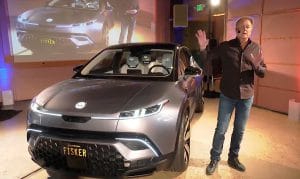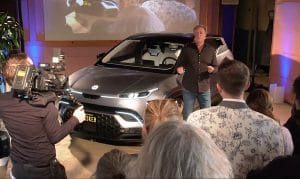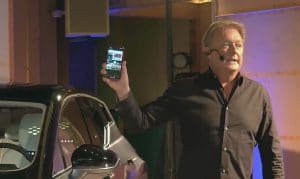Fisker Inc.’s new entry, the Ocean, making its debut at CES 2020 is not only paving the way for two more new vehicles and creating an all-digital automaker, but also the company expects to build 1 million EVs between 2022 and 2027.
“We have secured a global supply chain and manufacturing capacity that will result in projected production of more than 1 million vehicles between 2022 and 2027,” said Henrik Fisker, chairman and CEO of Fisker Inc., who declined to offer any more information, instead saying the company would share more details at the Geneva Motor Show, “including our fully-engineered platform and more technical specifications.”
The company revealed prior to the new ute’s debut at the Consumer Electronics Show in Las Vegas it was now taking $250 reservations for its new vehicle, scheduled to arrive in 2022. That money gives you the option to buy or lease the new all-electric ute, which will start with an MSRP of $37,995, or $29,995 after all applicable federal tax incentives.
(Fisker Ocean making formal debut at CES)
Drivers can get behind the wheel of the Fisker Ocean starting at $379 per month with $2,999 down before delivery in 2022, which includes both initiation and activation fees. Fisker will also offer a “$0 drive off” option through a fully financed $2,999 down payment for credit approved customers.
Unsurprisingly, most this can be handled digitally. The company’s is hoping to become the first all-digital automaker, and allowing customers to conduct research and make purchases using the company’s app or website is a step in that direction.
“We are looking at this direct to consumer approach,” Fisker said, adding the company was “looking to take out every single middle man that stands between us shipping a vehicle and you receiving it.”
Speaking to a small crowd, Fisker said this direct-to-consumer method – already in place with Tesla – is critical to getting the new Ocean in the hands of buyers for an “amazing price.”
Fisker noted that digital push is also crucial to keeping the cost for drivers down and the company wants as little “brick and mortar” as possible. Much of that is expected to be achieved through the use of technology, such as the company’s app.
(Fisker dips his toe in the Ocean with the new EV)
“When we began to design the Fisker Flexee app experience, we wanted to give our customers the power to access critical vehicle information, a unique media gallery, playable assets and more features that we will be adding over the next several months. Managing a Fisker vehicle and engaging directly with the company will be fun, hassle free and at your fingertips – anytime, anywhere.”
Fisker isn’t just looking to brand a vehicle with a better app, he noted, adding the vehicle uses technology to become a greener form of transportation, suggesting it “believes that the industry should stop looking at innovation superficially and start taking responsibility for its products, end-to-end – giving customers the opportunity to contribute to a more sustainable future.”
Fisker does that, according to the company, with its full-length solar roof that bolsters the vehicles’s power source, improving efficiency and lower emissions, accounting for “1,000 free, clean per year.” The company intends to work on improving the roof to squeeze more power out of it, and as a result, more free miles.
The vehicle also uses fully recycled carpeting made from regenerated nylon, which is produced from abandoned fishing net waste pulled from the oceans and aquaculture. Other parts of the interior are vegan, and it meets stringent chemical emission limits for various VOCs (such as Formaldehyde).
There are a slew of other features and actions taken in the design and production of the Ocean to reduce pollution, cut carbon dioxide emissions, use recycled materials and repurpose rubber waste to make the new Ocean as green a vehicle as one can find.
(Fisker teases all-electric CUV, hires manufacturing vet)
Not any bit of this green good news will benefit Fisker if the new SUV isn’t competitive in terms of its performance. The all-electric SUV will come standard with an extended range (target of approximately 250 to 300 miles, depending on driving conditions), enabled by an approximately 80 kWh lithium-ion battery pack. No other performance measurements, i.e. 0 to 60 mph, were released.



